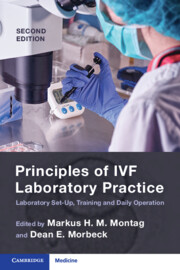Book contents
- Principles of IVF Laboratory Practice
- Principles of IVF Laboratory Practice
- Copyright page
- Contents
- Contributors
- Foreword
- The Evolution of IVF Practice
- Section 1 Starting a New Laboratory and Training Protocols
- Section 2 Pre-procedure Protocols
- Chapter 10 Mouse Embryo Assay for Quality Control in the IVF Laboratory
- Chapter 11 Sperm Survival Assay for Quality Control in the IVF Laboratory
- Chapter 12 Quality Control in the IVF Laboratory
- Chapter 13 Set-Up Procedures for Optimizing Performance in the IVF Laboratory
- Section 3 Gametes
- Section 4 Insemination/ICSI
- Section 5 Fertilization Assessment
- Section 6 Embryo Assessment: Morphology and Beyond
- Section 7 Embryo Cryopreservation
- Section 8 Embryo Transfer
- Section 9 Quality Management
- Index
- References
Chapter 11 - Sperm Survival Assay for Quality Control in the IVF Laboratory
from Section 2 - Pre-procedure Protocols
Published online by Cambridge University Press: 07 August 2023
- Principles of IVF Laboratory Practice
- Principles of IVF Laboratory Practice
- Copyright page
- Contents
- Contributors
- Foreword
- The Evolution of IVF Practice
- Section 1 Starting a New Laboratory and Training Protocols
- Section 2 Pre-procedure Protocols
- Chapter 10 Mouse Embryo Assay for Quality Control in the IVF Laboratory
- Chapter 11 Sperm Survival Assay for Quality Control in the IVF Laboratory
- Chapter 12 Quality Control in the IVF Laboratory
- Chapter 13 Set-Up Procedures for Optimizing Performance in the IVF Laboratory
- Section 3 Gametes
- Section 4 Insemination/ICSI
- Section 5 Fertilization Assessment
- Section 6 Embryo Assessment: Morphology and Beyond
- Section 7 Embryo Cryopreservation
- Section 8 Embryo Transfer
- Section 9 Quality Management
- Index
- References
Summary
The purpose of the human sperm survival assay (HSSA) is to test disposables, media and reagents for potential sources of cytotoxicity in a human assisted reproductive technology (ART) laboratories before their use in in vitro fertilization (IVF)/andrology procedures. The contact bioassay is a cornerstone of a successful and safe ART laboratory, and in many countries, the use of a contact bioassay is required by law. When using a bioassay in the laboratory, it must be useful rather than just fulfilling a legal requirement. This means that the assay should be able to detect very subtle levels of toxicity consistently without any false-negative or false-positive results. Several alternative contact bioassays have been described that may fulfil these requirements, but they are not all equally affordable, accessible and practical to execute. The use of human sperm in a contact bioassay is inexpensive and convenient, as well as invaluable for consistent quality assurance in ART laboratories. If used appropriately, the HSSA is sensitive, repeatable, readily available and each sample acts as its own control.
- Type
- Chapter
- Information
- Principles of IVF Laboratory PracticeLaboratory Set-Up, Training and Daily Operation, pp. 80 - 85Publisher: Cambridge University PressPrint publication year: 2023

